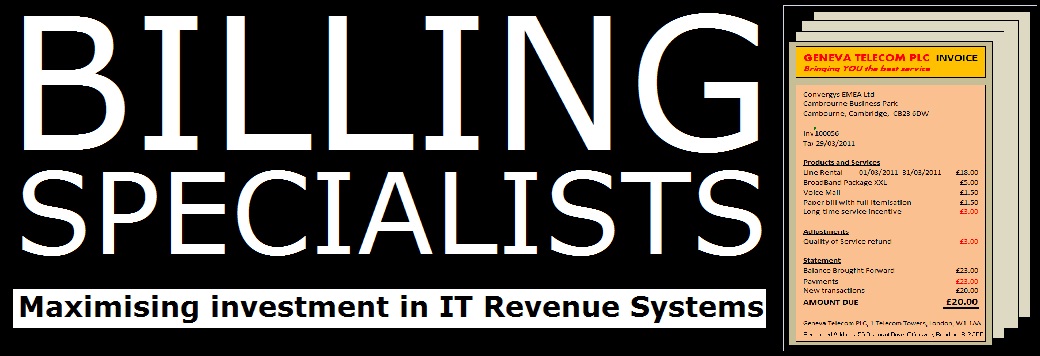|
Provisioning Mediation Rating Billing Collections Revenue Assurance Financials |

|
Installation Data Migration Upgrades Healthchecks Tuning Impact Assessments Technical Assurance |
|
Provisioning Mediation Rating Billing Collections Revenue Assurance Financials |

|
Installation Data Migration Upgrades Healthchecks Tuning Impact Assessments Technical Assurance |
Billing Specialists has signficant experience of Netcracker's Geneva/RBM™ software consultancy. Over the years we have worked on nearly every part of the application and have discovered its strengths and weaknesses, both through our experiences of using RBM (a.k.a. NetCracker Online Rating and Charging) and from talking to numerous operators.
On this page we give a high-level appraisal of RBM, as a flavour of our experiences. Please contact us if you would like one of our consultants to give a detailed presentation about RBM.
RBM is truly flexible, with configurable business rules (entered via GUIs or APIs) rather than customisation to the source code, which is essential for an operator to be faster to market than their competitors. There are no customer-specific versions of the core product. This is the true differentiator between RBM and rival rating and billing systems. There is no requirement for a permanent team of on-site consultants from the supplier.
There has been an increasing amount of bespoke functionaliy through operator-coded plug-ins, but arguably this has led to less configuration through the GUIs.
It can be used for any customer model: residential, corporate, wholesale, post-pay, pre-pay, covergent billing, any-country, any-language any tax, all existing in the same database. It also scales out to multiple servers and multiple tiers, although the GUIs do still have scalabiltiy issues.
Because RBM is a 'bill anything to anyone' product there is no default configuration, e.g. for telephony. This is a weakness that systems integrators have often exploited by replicating an installation from one client to another. An operator doing their own configuration has considerable work to do.
There is no market-specific RBM documentation, for example, telephony, to aid configuration. A particular weakness of the installation and upgrade technical documentation is that it mentions all NetCracker Smart Revenue components, rather than just the core RBM so operators have trouble 'seeing the wood for the trees'. This has benefited Billing Specialists, in particular, as we will know immediately what is relevant to an operator.
In the past there have been issues around holding multiple shapes of data (e.g. residential and wholesale, or telephony and utility) in the same database, although most of these limitations have now been overcome as processes have been made more granular and therefore able to process customer types differently.
NetCracker has sensibly leveraged existing functionality to extend the core product. For example, overdue/late payment fees utilise one-time charge functionality.
Occasionally things appear to be done 'on the cheap', such as making functionality available in a GUI but not in browser-based API set or vice versa, in order to meet the requirements of a specific operator.
The default behaviour is sometimes not the common or sensible setting - hence more initial configuration is necessary than ought to be the case.
Like the IT industry generally there has been a lack of quality control in certain areas. There has also been a lack of large volume testing and, for example, testing processes with non-US settings. Billing Specalists, in particular, can advise on which parts of the rich functionality are advisable to use and which come with a 'health warning'. Just a couple of days' impartial consultancy is a wise investment if pitfalls are then avoided.
On the plus side NetCracker is often quick to fix problems when they are reported, although very old versions are normally considered 'out of support'.
RBM is such a flexible product and operators have used it in ways that the developers never envisaged and this has obviously led to performance problems, which NetCracker has the had to resolve, sometimes by having to make schema changes.
The product was arguably under better control when owned by single-product Geneva Technology Ltd as it was a best of breed single application. It was then bought by Convergys and their attempts to integrate it with their other products has historically been poor. The company's ownership of multiple rating and biling offerings has seen a lack of direction on the way ahead, which in BSL's opinion is to provide just one powerful rating and billing solution, namely RBM, across all markets and not to persist in selling relics such as ICOMS.
Despite some weaknesses, RBM is so flexible and powerful that it should be used in far more industries than it is. However, this really requires an RBM-lite edition. Without it an operator needs either a substantial customer base or usage traffic to consider using RBM.
We strongly recommend that an operator considering a new rating and billing system involves impartial experts such as Billing Specialist Ltd in their procurement process.